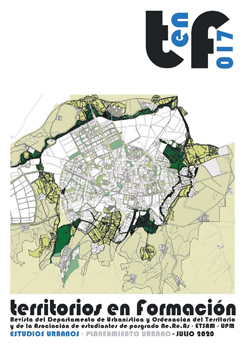La Frontera Interior: proceso comunitario e impacto urbano en los espacios colectivos de apropiación ciudadana del distrito de Tetuán = The Inner Border : Community Process and Urban Impact in the Citizen Appropriated Collective Spaces of the Tetuán District
DOI:
https://doi.org/10.20868/tf.2020.17.4485Palabras clave:
Comunes urbanos, huertos urbanos, autogestión, tercer sector, paisaje urbano, derecho a la ciudad, Urban commons, community gardens, self-management, third sector, urban landscape, right to the cityResumen
Resumen
La autogestión de espacios colectivos organizada por comunidades locales es con frecuencia objeto de una estetización de lo colectivo o es reducida a una forma de ocio urbano, obviando la base política y espacial específica de cada iniciativa. Los espacios autogestionados son una forma de producción alternativa de espacios colectivos y potencialmente una plataforma para la innovación social. El estudio se centra en el distrito de Tetuán como parte de la periferia interior madrileña, como objeto de procesos urbanos de transformación y gentrificación, así como enclave de resistencia y activismo vecinal. Se sostiene que el proceso comunitario es la clave de la sostenibilidad de los espacios colectivos de apropiación ciudadana y no puede ser cooptado por la administración. La apropiación ciudadana surge como respuesta a conflictos y necesidades tanto sociales como espaciales, instaurando espacios de resistencia en un contexto de conflicto urbano.
Abstract
Self-management of collective spaces, organized by grassroot communities, often falls under an aestheticization of the collective or is reduced to anecdotic urban leisure, leaving out the spatial and political bases of each specific initiative. Self-managed spaces present an alternative production of collective spaces and can be a platform for social innovation. The study focuses on the Tetuán District as an enclave in the inner periphery of Madrid. The neighbourhood has experienced deep urban transformations and is under a process of gentrification. It is also a space of community resistance where neighbourhood activism has a long tradition. It is argued that the community process is the key for the sustainability of appropriated collective spaces and cannot be co-opted by the administration. These spaces are a reaction to spatial and social conflicts and necessities, creating rebel spaces in a context of urban conflict.
Descargas
Referencias
Alguacil, J. (2000). Calidad de vida y praxis urbana: Nuevas iniciativas de gestión ciudadana en la periferia social de Madrid. Colección “Monografías” (Vol. n. 179).
Alguacil, J. (2014). La ciudadanía emergente y sus síntomas. Boletín CF+ S, (24): 129–135. Retrieved from http://habitat.aq.upm.es/boletin/n24/ajalg.html
Baker, S., & Mehmood, A. (2015). Social Innovation and the Governance of Sustainable Places. Local Environment: The International Journal of Justice and Sustainability, 20 (3): 321–334. https://doi.org/10.1080/13549839.2013.842964
Borja, J. (2013). Revolución urbana y derechos ciudadanos. Alianza Editorial.
Cadenas, M. (Observatori dÁntropologia del C. U. (2015). El Urbanismo del Mientras Tanto. Primeras Notas Etnográficas sobre Prácticas de Construcción Colaborativa en Tiempos de “Crisis.” In G. Aricó, J. A. Mansilla, & M. L. Stanchieri (Eds.), Mierda de Ciudad, Una Rearticulación Crítica del Urbanismo Neoliberal desde las Ciencias Sociales. Barcelona: Pol-len edicions.
Chombart de Lauwe, P. H. (1976). Appropriation de l ’ espace et changement social. Cahiers Internationaux de Sociologie, 66: 141–150. Retrieved from ttp://www.jstor.org/stable/40689859
Commune di Bologna, & LabGov. Regulation Bologna City and Commons. Retrieved from http://www.comune.bo.it/media/files/bolognaregulation.pdf
De Angelis,M y Stavrides, S. (2010). On the Commons: A Public Interview with Massimo De Angelis and Stavros Stavrides. E-Flux, 17. Retrieved from http://www.e-flux.com/journal/17/67351/on-the-commons-a-public-interview-with-massimo-de-angelis-and-stavros-stavrides/
Foster, S., & Iaione, C. (2015). The City as a Commons. SSRN Electronic Journal. https://doi.org/10.2139/ssrn.2653084
Giddens, A. (1999). Consecuencias de la modernidad. Alianza Editorial.
Harvey, D. (2012). Ciudades Rebeldes. Del Derecho de la Ciudad a la Revolución Urbana. Madrid: Akal.
Hernández Aja, A. (2003). Ciudadanos fecundos: Participación y calidad de vida. Ecología y Ciudad: Raíces de Nuestros Males y Modos de Tratarlos: 247–266. Retrieved from http://habitat.aq.upm.es/boletin/n24/aaher.html
Ingersoll, R. (2006). Sprawltown, Looking for the City on Its Edges. Nueva York: Princeton Architectural Press.
Kozlovsky, R. (2006). The Junk Playground : creative destruction as antidote to delinquency. Threat and Youth Conference, 1–10. Retrieved from http://threatnyouth.pbworks.com/f/Junk Playgrounds-Roy Kozlovsky.pdf
Lefebvre, H. (2013). La Producción del Espacio Urbano. Capitán Swing. Madrid: Capitán Swing.
Low, S. M., & Altman, I. (1992). Place Attachment a Conceptual Inquiry. In I. Altman & S. M. Low (Eds.), Place attachment (pp. 1–12). Boston, MA: Springer US. https://doi.org/10.1007/978-1-4684-8753-4_1
Manzini, E. (2011). The New Way of The Future: Small, Local, Open and Connected. Social Space, 100–105. Retrieved from https://ink.library.smu.edu.sg/lien_research/75
Martinez, E. (2016). Configuración urbana, habitar y apropiación del espacio. Scripta Nova. Revista Electrónica de Geografia y Ciencias Sociales, 18 (493): 21. https://doi.org/https://doi.org/10.1344/sn2014.18.15022
Moulaert, F., Martinelli, F., Swyngedouw, E., & González, S. (2005). Towards alternative model(s) of local innovation. Urban Studies, 42(11): 1969–1990. https://doi.org/10.1080/00420980500279893
Ostrom, E. (2015). Governing the commons: The evolution of institutions for collective action. Governing the Commons: The Evolution of Institutions for Collective Action. https://doi.org/10.1017/CBO9781316423936
Pradel Miquel, M., & Garcia Cabeza, S. (2018). Innovación social en las ciudades españolas la centralidad de la gobernanza local y ciudadana. In M. Pradel Miquel & S. Garcia Cabeza (Eds.), El momento de la ciudadanía: innovación social y gobernanza urbana (pp. 13–31). Madrid: Los Libros de la Catarata.
Sennett, R. (2018). Building and Dwelling: Ethics for the City. Allen Lane.
Stavrides, S. (2015). Common space as threshold space: urban commoning in struggles to re-appropriate public space. Footprint, (16), 9–20. https://doi.org/10.7480/footprint.9.1.896
Vidal Moranta, T., & Pol Urrútia, E. (2005). La apropiación del espacio: Una propuesta teórica para comprender la vinculación entre las personas y los lugares. Anuario de Psicologia, 36 (3): 281–297.









